Posted by James Blanchard on 02-26-2007 04:57 AM:
Baluch? kilim
Hi all,
Generally, Baluch-type weavings are known for their relatively
subdued colours. However, as has been noted by others, the Baluch palette and
"aesthetic" is somewhat eclectic (see Tom Cole's article on "Baluch Aesthetics"
http://www.tcoletribalrugs.com/article15baluchstyle.html ).
During a recent trip to Pakistan I acquired a couple of "un-Baluch"
Baluch-type weavings that seem to stray beyond the usual Baluch palette and
aesthetic. Perhaps one explanation is that neither is very old, so some of the
traditional designs and colour schemes had been eschewed for newer approaches.
In any case, I would be interested in feedback from others.
The first
piece is a kilim measuring approx. 7' x 4'8" (212 x 140 cm). It is made using a
variety of techniques including slit-weave tapestry and weft-float in typical
"Baluch" style. Though the kilim does show signs of age, I think that there are
some synthetic dyes and I would place the age at somewhere in the 50-80 year
range. The range of colours and the prominent "step medallion" designs seem a
little outside the usual Baluch repertoire for kilims. The closest analogy I
have found is the magnificent kilim illustrate in Boucher's "Woven Treasures"
(plate 51). It also has the bold "stepped medallions", and also seems to have
some synthetic dyes. Boucher dates it to c. 1920 and attributes it to the
"Baluchistan region, Pakistan-Afghanistan border area". The dealer from whom I
acquired this one said it was made by the "Aimaq people" in the Qala-e-Now
region.
Any thoughts about attribution, age, aesthetics,
etc.?
James.

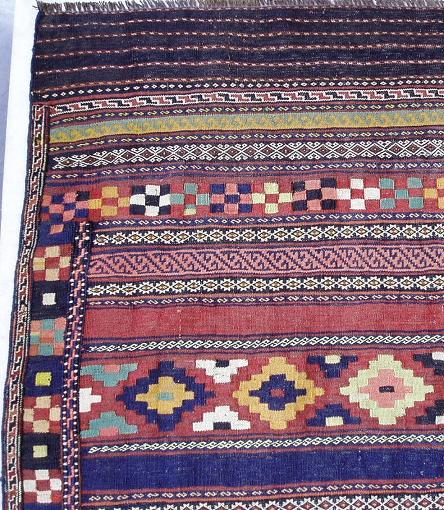
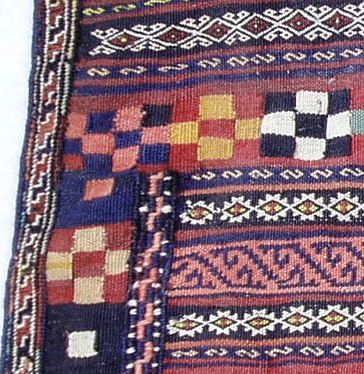
Posted by Tim Adam on 02-26-2007 07:58 AM:
Hi James,
It could be that your kilim is Luri. I say that because I
own something vaguely similar. It was sold as Gashgai, but I think the
relatively course structure and the dark goat hair warps point towards
Luri.
Tim
Posted by James Blanchard on 02-26-2007 08:09 AM:
Thanks, Tim.
I hadn't thought about Luri, or South Persian for that
matter. Other than the dark warps, I wonder if the structure is consistent with
a S. Persian flatweave. What do others think?
James.
Posted by Filiberto Boncompagni on 02-26-2007 11:03 AM:
Hi James,
I think that:
1 - It’s a very nice piece.
2 - It’s
probably Afghan.
3 - I saw something similar, somewhere, besides Boucher's
"Woven Treasures". Have to look around.
Regards,
Filiberto
Posted by Steve Price on 02-26-2007 11:09 AM:
Hi James
The palette looks more like what I'd expect in a south
Persian piece, but the strips of white brocading on a black background are so
typically Belouch that I believe that it's a Belouch
piece.
Regards
Steve Price
Posted by James Blanchard on 02-26-2007 11:29 AM:
Thanks Filiberto and Steve.
Filiberto, do you mean "Baluch-type"
Afghan, or another Afghan weaving group? I hope you are able to find an
analogy.
Steve, I also find the brocaded strips to be quite persuasively
Baluch. For what it is worth, the dealer said he acquired it in Afghanistan
(Herat), which doesn't rule out a S. Persian origin but seems to make it
somewhat less likely than an Afghan source. He seemed quite sure it was from the
Qala-e-Now area.
By the way, the colours look more saturated in real
life than they look on the screen (especially when I compare the full-size
photo).
James.
Posted by Filiberto Boncompagni on 02-26-2007 12:14 PM:
Hi James,
I mean Baluchi-tipe, because the brocaded stripes look quite
Baluch. However, also the Afshars of Kerman use mostly the same motifs… But not
together with the kilim part of yours, if memory serve. Well, I’ll look better
tomorrow.
Regards,
Filiberto
Posted by Tim Adam on 02-26-2007 11:33 PM:
Actually, I find those brocaded bands the only part of James' kilim that is
reminiscent of Baluch.
Below is the Luri kilim that I thought is somewhat
similar.

Tim
Posted by James Blanchard on 02-27-2007 12:22 AM:
Hi Tim,
I agree that most of the features of my kilim are "un-Baluch",
as I mentioned in my first post. I still lean towards a Baluch attribution based
on the preponderence of evidence, but would like to keep an open mind about
it.
I can't see the picture of your Luri kilim
yet.
Cheers,
James.
P.S. Here is another picture of the
kilim, which better represents the colours. The colours in the previous photos
looked to weak on my computer screen.
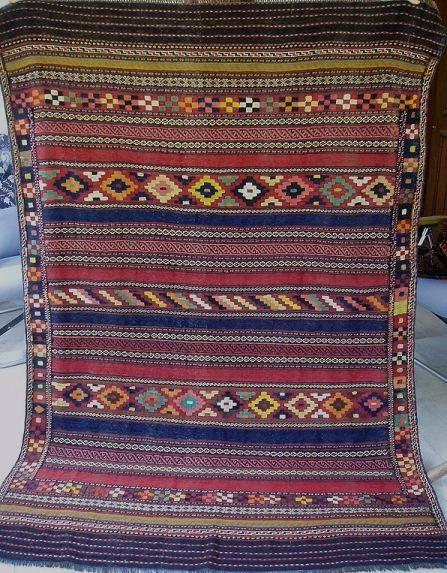
Posted by Steve Price on 02-27-2007 12:41 AM:
Hi Tim and James
The image of the Luri kilim is in the server now, and
displays in Tim's last message..
Steve Price
Posted by James Blanchard on 02-27-2007 12:53 AM:
Hi Tim,
Nice kilim! I see the similarities, but still think it would
be a stretch to place mine in the Luri or S. Persian category. What do others
think?
James.
Posted by richard tomlinson on 02-27-2007 05:23 AM:
hi james
i would guess definitely not baluch.
i think tim is
on the right track. at first glance i thought kurdish work. i would say
'persian' but not sure which group.
richard tomlinson
Posted by James Blanchard on 02-27-2007 05:36 AM:
Thanks Richard.
Apart from Baluch, the only other group I had
entertained was "Kurd". Perhaps it could be postulated that this weaving is a
product of the confluence of Kurdish and Baluch groups.
Does anyone have
any other analagous examples from Persian weaving groups (both in design and
structure) to offer?
Also, if anyone has a copy of Boucher's "Woven
Treasures" and a scanner, perhaps they could scan and post a picture of the
"Baluch" kilim illustrated in plate 51. It seems somewhat analagous to
me.
Cheers,
James.
Posted by Filiberto Boncompagni on 02-27-2007 05:55 AM:
Hi James,
I didn’t find what I was looking for, but I have some more
material for you.
First, I have to divagate a little.
I don’t know if
you remember my “unique” Baluch salt bag I posted some time ago:

Anyway, it
prompted for me a search for similar examples. I had little doubt it was a
Baluch weaving. See for example the same motif on the brocaded skirt of the
“Doktor-i-Ghazi” prayer rug” of the V&A Museum:
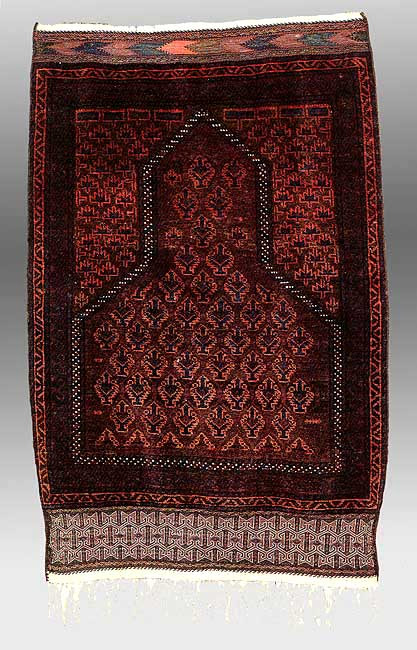
and similar Baluch
namakdans on the web:
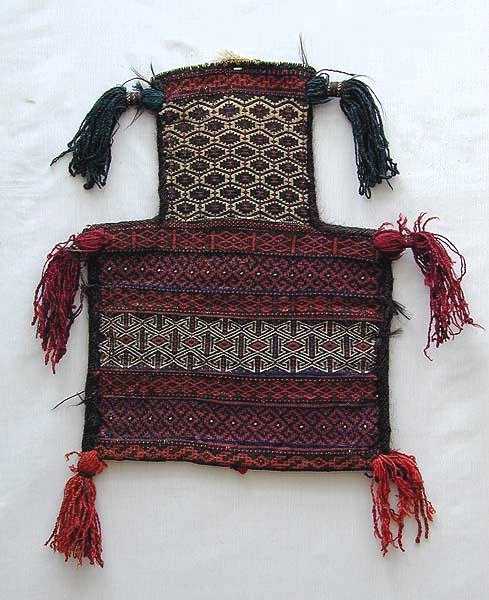

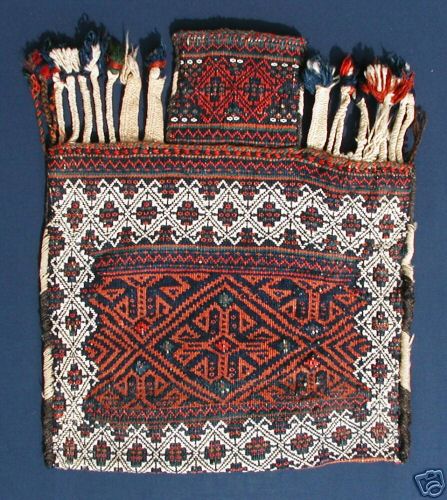
BUT… in A.Hull and J. Luczyc-Whowska’s “KILIM“. Page 223 there
is a so-called Afshar salt bag that is almost identical to the one above (so
identical that I didn’t scan it).
And, on a Italian book “Il Tappeto
Persiano” I found two other bags labeled as “Baluch-Afshar:
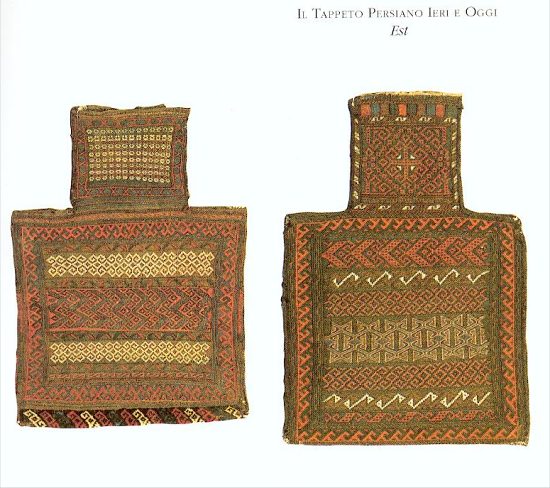
Then there is, For
Richard’s benefit, this namakdan from “Kordi Tribes, Quchan Region,
Korassan”
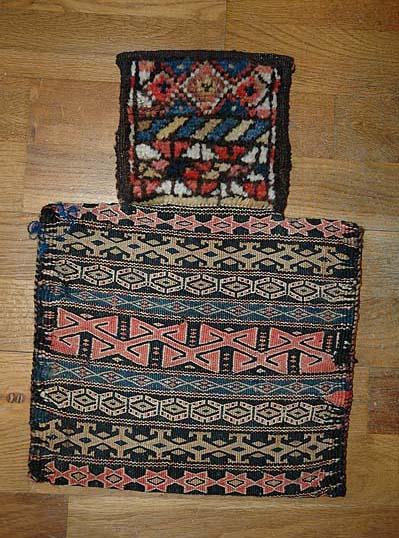
There is, without doubt, a cross-fertilization of motives in
Afshar-Baluch area.
See Ford’s “Flatweaves of Kerman Province”:
http://www.rugreview.com/122b.htm
And Wertime’s article
“Some salt Bags from Kerman Province” http://www.rugreview.com/6wert.htm
Which makes
difficult to distinguish the provenance of flat-weaves. On “KILIM” it’s said
that Afshar kilims have a “dense and heavy feel other types lack.”
Let’s
go back to pictures of kilims, after all those namakdans. The followings are all
attributed to the Afshars. They are on sale, so my apologies to the unmentioned
seller:
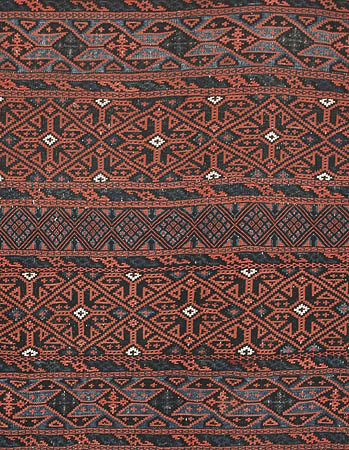
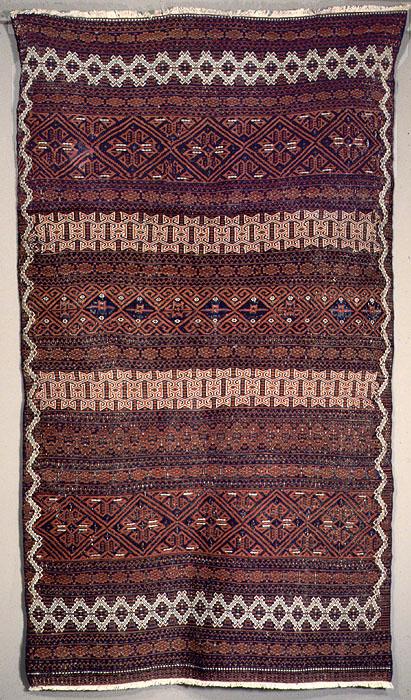
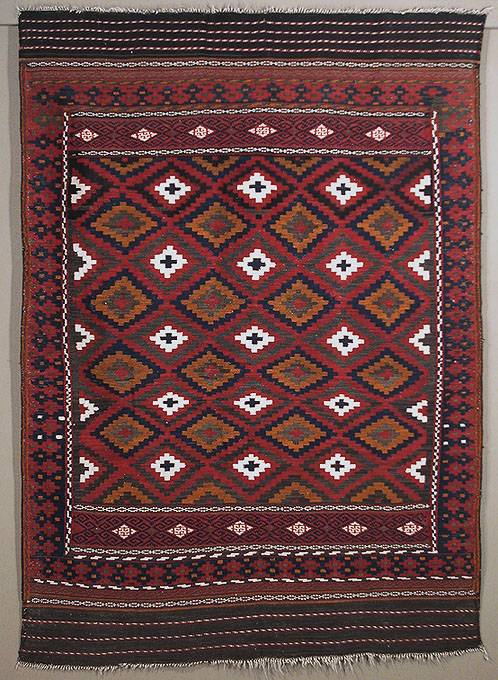
I just found the last one, which is the most similar to yours.
Same “skirts” also.
So… I don’t know.
Shall we settle for a Baluch-Afshar
label? 
Regards,
Filiberto
Posted by Filiberto Boncompagni on 02-27-2007 06:20 AM:
Hi James,
quote:
if anyone has a copy of Boucher's "Woven Treasures" and a scanner, perhaps
they could scan and post a picture of the "Baluch" kilim illustrated in plate
51. It seems somewhat analagous to me
Voila’ the scan, followed by your kilim and by the similar
Afshar:
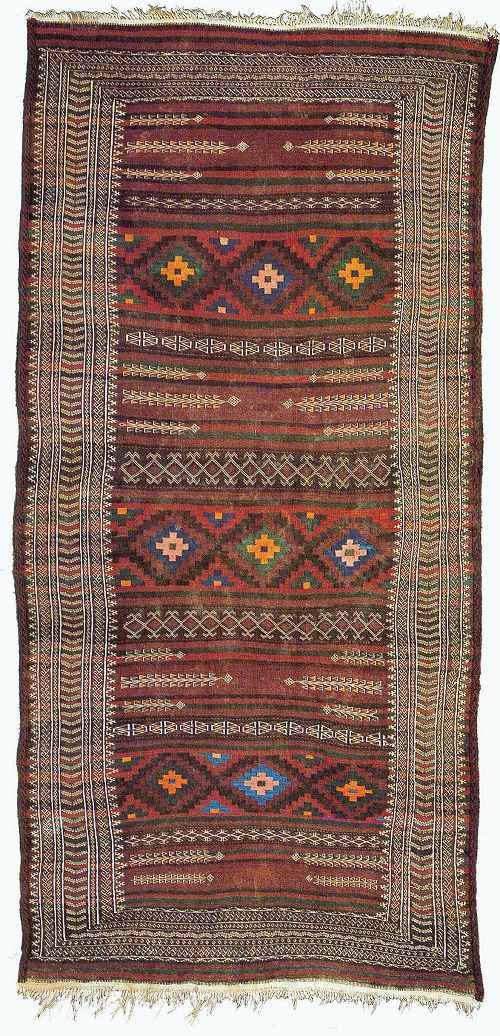


Regards,
Filiberto
Posted by James Blanchard on 02-27-2007 06:33 AM:
Hi Filiberto,
Thanks for the detective work! 
Boucher's kilim also
looks a bit "un-Baluch", don't you think?
I am happy enough with
Afshar-Baluch, or some such categorization.
That's a nice array of salt
bags. I have a couple of large bags that seem to be similar (I've shown them
before, see below). Regarding my bags Parviz Tanavoli indicated that they are
"the work of Jabalbarezis" who live "way south of
Kerman".
James.
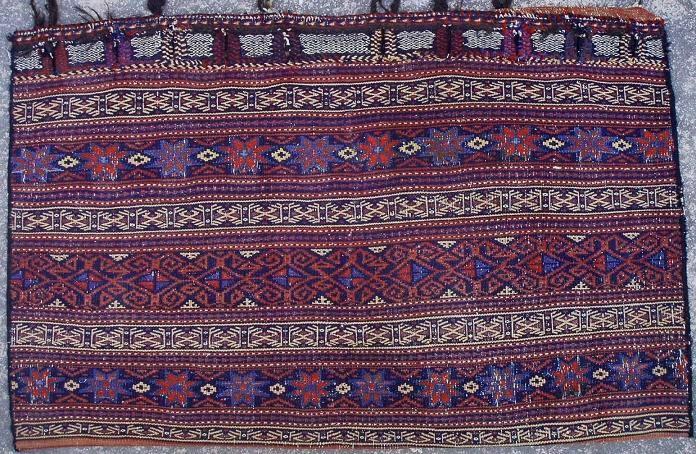
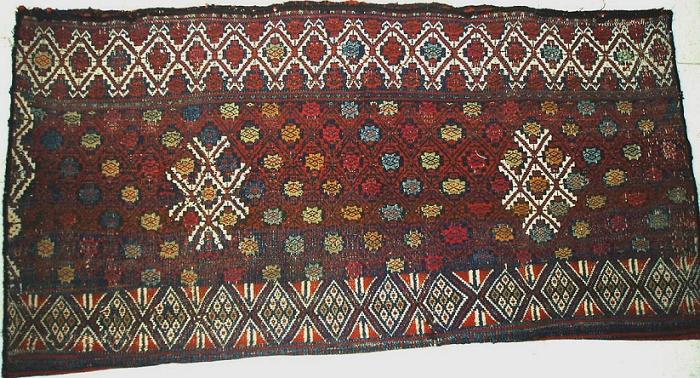
Posted by Chuck Wagner on 02-27-2007 07:21 AM:
Hi James,
I admit that some of the Afshar pieces that Filiberto has
found look like valid analogs for your piece. There is another possibility,
which I think should be considered because of what your dealer said: Qala-i-nau
is northeast of Herat, and kilims with several characteristics similar to those
of your piece are made there.
The biggest departure is the field design,
which could be definitive - I agree with Steve - the palette looks Persian.
Nevertheless, the drift away from traditional designs that is seen in the 20th
century could explain that. Here are a couple images of a more traditional piece
(posted previously in other discussions), Still, it is probably not more that
50-60 years old - the oldest pieces are made of two more narrow strips, stitched
together.
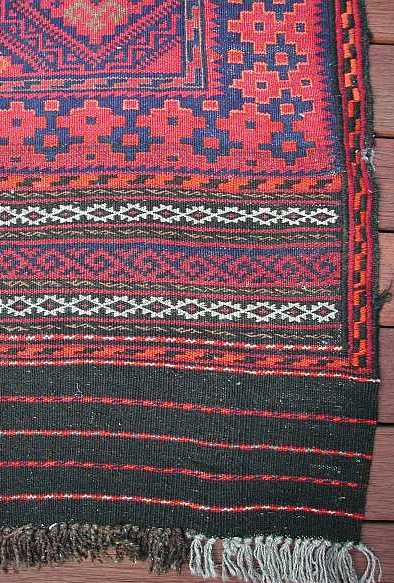
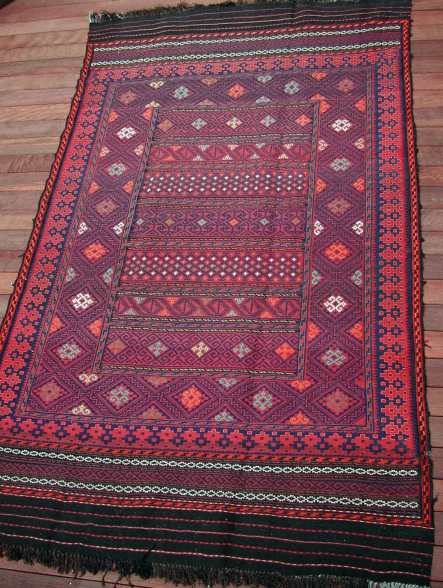
Regards,
Chuck Wagner
__________________
Chuck
Wagner
Posted by Filiberto Boncompagni on 02-27-2007 08:06 AM:
Hi Chuck,
Yes, that’s another possibility.
About Boucher’s
plate 51, said to be "Baluchistan region, Pakistan-Afghanistan border
area"…
Plate 122 of Jenny Housego’s Tribal Rugs shows a B&W
picture of a “Flat-woven rug, Baluchi, East Iran”, probably “made on the
borderlands with Afghanistan, south of Heart”.
Fact is that it looks like
Boucher’s plate 51 without the kilim parts. 
Unhelpfully,
Filiberto
Posted by Jack Williams on 02-27-2007 09:21 PM:
Baluch; two, three, four
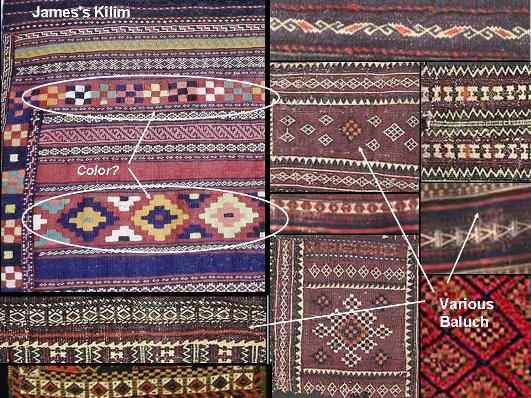
In my
opinion, there are some aspects of James's kilim that have an Afshar look,
specifically the small red and blue "S" guard border on the extreme outside.
However, the rest of the kilim looks very baluch when you break out the
individual segments.
Like Filiberto, I was looking at a lot of NW Afgan
salt bags because not a lot of baluch kilims are available on the net
(Filiberto, that is a great summary, worth saving...which I shall).
What I
did in the above picture was cut and paste a bunch of segments of baluch
saltbags and some flatweaves or mixed weaves. I only borrowed those that were
id'd as baluch by top experts. By juxtaposing these segments against James's
kilim, I think that the aura of baluch in that kilim begins to be much more
apparent.
So what makes the kilim have a faintly alien air? I think it is
strictly the color composition of the parts of the kilim I circled. But when we
look at those specifically, we find they only have four colors, and individually
none of those colors could be said to be "non baluch." Therefore it might be the
light-dark color juxtaposition that looks non-baluch. But given the breath of
baluch group weavings, I think it would be a mistake to try too hard to make it
something else.
I personally tried to make it (a) "Kordi" Kurd-Quchon;
(b) Maimanya Uzbek from NE of Herat; and (c) Afshar...but when I put James's
against kilims from those sources, it didn't look very happy. I think it looks
very content in the attached picture, nestled in with its Baluch friends. I
think the dealer's attribution is probably accurate
...and to try and
make this S. Persian ignoring the obvious individual Baluch
characteristics...well... maybe there are s.persian tribal people who weave in
weft sub brocade. I just am not familiar with them.
Posted by James Blanchard on 02-27-2007 11:51 PM:
Hi Jack,
Thanks for this analysis. The kilim does seem to be a mix
between Baluch and non-Baluch structure, palette and aesthetics.
I have
communicated by email with someone very knowledgable with Baluch and other
weavings of Afghanistan and Central Asia. He thinks it is made by a non-Turkmen
central Asian group such as the Uzbek, Aimaq, or Qizilbosh. The dealer said that
it was "Aimaq".
Cheers,
James.
Posted by Chuck Wagner on 02-27-2007 11:59 PM:
Hi James,
The kilims of Qala-i-Nau are made by Hazara Aimaq
weavers.
Regards,
Chuck Wagner
__________________
Chuck
Wagner
Posted by Filiberto Boncompagni on 02-28-2007 03:41 AM:
Hi James,
OK – Here’s a scan from a book which isn’t worth of mention
(one of the reasons is that the author copied shamelessly most of the
text from A.Hull and J. Luczyc-Whowska’s “KILIM” – the other is that, on top of
it, she managed several misspellings):

As you can see, the
pieces are from the 1960s. The “Maimina” mentioned in the captions should be
Maimana, I gather.
A "source" of kilim very close to yours (well, the kilim
part). The colors are bad in the photos, the mentioned green is not visible and
the yellow looks more orange, but it could be the same palette.
A look at
Parsons’ “The Carpets of AFGHANISTAN” tell us that: “The main goods offered for
sale (at the Maimana bazaar) are flat-woven khourjeens and kilims…
made by all tribes throughout the area. The Maimana kilim traditionally
woven by Uzbeks is still being made today by these same people and also being
copied by Aimaqs.”
And Qala-e-Now is close to Maimana…
All
considered, I agree with Chuck & Jack: your dealer should be
right.
Regards,
Filiberto
Posted by Richard Larkin on 02-28-2007 08:21 AM:
Hey gang,
The similarities and apparent cross-fertilizations among
these pieces are quite striking when grouped together this way (and so
impressively quickly!) by many of our able contributors. For example, in the
montage put up by Filiberto, I am looking at the first kilim coming after the
string of Namakdans, which is attributed to the Afshar. It looks more like
Baluch than James's starter piece; that repeating diamond motif is one of the
most ubiquitous of traditional Baluch designs, not to mention the two-bladed
propeller. Of course, we are relying on the attributions of others, which begs
tha same questions James laid down in the original post. It all emphasizes the
fact that these attributions are usually more complicated than we want to
acknowledge.
I'm hardly up to sorting out all the tribes mentioned, but
I'll throw in the Veramin card here. Some of those white motifs in weft float
technique on the dark background are reminiscent of that area, no? Do I recall
that the Luri are part of the Veramin weaving complex?
__________________
Rich
Larkin
Posted by James Blanchard on 02-28-2007 08:46 AM:
Hi all,
Indeed this is an impressive array of information and
analogies, though I am left without a very definitive attribution.
I
think the dealer is not too far wrong. He did say that he used to see an
occasional one like this about 30-40 years ago when he was based in Herat, but
hasn't seen one like this for quite a while. I have grown to trust his judgement
and attributions, and he seldom seems to exaggerate about
age.
Regardless, I think it is an interesting piece with its own
charm.
James.
Posted by Patrick Weiler on 02-28-2007 10:07 AM:
How did she do that?
James,
You mention the variety of techniques used in your kilim. You
did not specify dovetailed, single interlocking or double interlocking tapestry
weave. Uzbeks often used double interlocking, as well as Bakhtiari/Luri
weavers.
Here, again, is my little Uzbek (maimana) salt bag with double
interlocking tapestry weave - and the stepped diamond design from your
kilim:
![]()
Patrick Weiler
Posted by James Blanchard on 02-28-2007 11:28 AM:
Hi Patrick,
You said: "You did not specify dovetailed, single
interlocking or double interlocking tapestry weave."
Ummmmm... what is
that? I guess that explains why I didn't mention it.
In this thread there have
been a few suggestions that a particular technique is an important clue to
attribution, but it seems like structural considerations are pointing in a
number of directions at the same time. Unfortunately, I don't know the field
nearly well enough to know how these structural clues would narrow down the
candidate weaving groups.
James.
Posted by Patrick Weiler on 02-28-2007 07:25 PM:
911 Marla!
James,
I recommend the book Woven Structures, A Guide to Oriental Rug
and Textile Analysis, by Marla Mallett. I consider it indispensable to
understanding the construction - and often the origin - of rugs and
flatweaves.
In simple slit-weave tapestry, the weft threads go over and under
the warps. At color changes, the weft goes around a warp and then returns back
the other direction. The next color starts at the next warp thread beyond the
last encircled warp of the first color, causing a gap, or slit, between colors.
Long slits weaken the fabric, requiring steps, diamonds and diagonals to reduce
the slze of the slits.
Dovetailing requires the first weft color to go
around a warp and then return and the second weft color encircles that same warp
thread from the other direction, eliminating the slit between colors. With two
color wefts on these shared warps, there is a bulge and zig-zag pattern at the
color changes.
In single interlocking, where the first color weft
encircles the last warp, instead of returning back immediately, a loop remains
and the next color weft enters, or is inserted into, this loop like two chain
links attaching to each other. This interlocking is between the last warp
encircled by the first weft and the first warp encircled by the second weft.
This technique causes a jagged edge in the design at color changes.
In
double interlocking, each new color weft is inserted through two weft loops of
the first color, in staggered rows, making quite a strong fabric, with
noticeable ridges on the back. It is not considered a two-sided fabric due to
these ribbed junctions.
Certain tribes use these different techniques
regularly enough to allow differentiating them when the designs and other
factors cause confusion.
Double interlocking is common in Baktiari weaving. A
similar Qashqai kilim may be slitweave. Afshar of Khorassan would use slitweave
and double interlocking. A comprehensive structural analysis of your piece could
either confirm the origin or just cause hopeless confusion!
It is
probably simpler to identify structures than to become an auto mechanic or
pediatrician, but having the Woven Structures book makes it a lot
easier.

Patrick Weiler
Posted by Gene Williams on 03-01-2007 04:39 AM:
Baluch Kilem
Hi all,
Lad Duane sent me an e-mail saying he saw a number of such
Kilems in the Qur-e Now area when he was up there 18 months ago. He's not sure
if is old-old since is saw new kilems very much like it.
As for color in
Baluch flat-weaves...I have two grain bags which are green with several bright
colors and two more which are bright yellow. I'll have to wait posting these
until I get back home again...I back in Herat. I may take a picture of James'
Kilem to the local carpet street here. But I trust Lad's
attribution.
Gene Williams
Posted by James Blanchard on 03-01-2007 06:11 AM:
Thanks Gene,
I'm not sure how old my kilim is, but I am quite sure it
is not very close to new. In addition to the patterns of wear, it has a number
of repairs that look a bit remote. So I tend to think it is at least a few
decades old. I am not sure that makes so much difference in the context of
determining attribution, so Lad might be right. Still, I would be keen to see
other analagous examples if you or Lad can provide them.
James.
Posted by Gene Williams on 03-13-2007 03:37 AM:
Qala-e-Now
James,
I think it was Chuck who mentioned that kelims in Qala-e-Now
(there are several versions of he spelling) are made by Hazara Aimaqs. I'm not
quite comfortable with this id. Most of the people in Herat I've talked to say
there aren't any Hazara in Badghis province (Qala-e-Now is capitol of
BAdghis...just east of Herat). It is mostly Tadjik (70% with about 20% Pushtun -
Sarbani - Abdali (Durrani) mostly) and some Uzbek and Turkmen, some Taimani.
Aimaq I supposed could be there...
Actually, I've never quite understood
the relationship between Aimaq and Turks. Babur mentions them in the Baburnama
and its clear he didn't regard the as part of the Turk-Turkoman nation as
created by Timurlame. They're supposedly a "Turkish-Mongol"combo...I think
someone once said they're called Timuri on the Iranian side implying that the
are indeed Timurid...í.e. Turkish related to Timur (who of course had Mongol
blood from Ghenghis Khan)..but its still not totally clear. I'll ask around
here.
I'm checking this out further. I've also printed off a copy of your
Kelim which I'll show around this week.
I like that
Kelim.
Gene
Posted by James Blanchard on 03-13-2007 05:12 AM:
Hi Gene,
Thanks for following up on this. I have also had someone
share the opinion that it might be Uzbek or some other group in that area. I
would be interested to see what dealers in that vicinity have so say about its
attribution.
Cheers,
James.

























